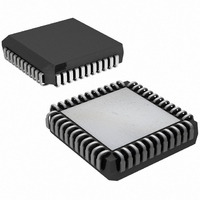DS2180AQN+ Maxim Integrated Products, DS2180AQN+ Datasheet - Page 22

DS2180AQN+
Manufacturer Part Number
DS2180AQN+
Description
IC TRANSCEIVER T1 IND 44-PLCC
Manufacturer
Maxim Integrated Products
Datasheet
1.DS2180A.pdf
(35 pages)
Specifications of DS2180AQN+
Function
Transceiver
Interface
T1
Number Of Circuits
1
Voltage - Supply
4.5 V ~ 5.5 V
Current - Supply
3mA
Operating Temperature
-40°C ~ 85°C
Mounting Type
Surface Mount
Package / Case
44-LCC, 44-PLCC
Includes
Alarm Generation and Detection, B7 Stuffing Mode, B8ZS Mode, Error Detection and Counter, "Hardware" Mode, Transparent Mode
Lead Free Status / RoHS Status
Lead free / RoHS Compliant
Power (watts)
-
4. RLOS transitions high during the F-bit time that caused an OOF event (any two of four consecutive
HARDWARE MODE
For preliminary system prototyping or applications which do not require the features offered by the serial
port, the transceiver can be reconfigured by the SPS pin. Tying SPS to V
all internal registers except CCR and TCR and redefines pins 14 through 18 as mode control inputs. The
hardware mode allows device retrofit into existing applications where mode control and alarm
conditioning hardware is often designed with discrete logic.
HARDWARE COMMON CONTROL
In the hardware mode bits TCR.2, CCR.4, TCR.0, CCR.1 and CCR.2 map to pins 14 through 18. The
loop-back feature (bit CCR.0) is enabled by tying pins 17 (zero suppression) and 18 (B8ZS) to 1. (The
last states of pins 17 and 18 are latched as when both pins are taken high, preserving the current zero
suppression mode). Robbed bit signaling (bit TCR.4) is enabled for all channels. The user may tie TSER
to TABCD externally to disable signaling if so desired. Bit CCR.3 is forced to 0 which selects bit 2
yellow alarm in 193S framing. Contents of the RCR, as well as the remaining bit locations in the CCR
and TCR are cleared in the hardware mode. The
resync and has no effect on transmit.
HARDWARE MODE Table 6
NOTES
1. Tying pins 17 and 18 high enables loopback in the hardware mode.
2. Bit 2 (193S) and data link (193E) yellow alarms are supported.
3. S-bit yellow alarm (193S) is not internally supported; however, the user may elect to insert external S
4. Pin numbers for PLCC package are listed in parenthesis.
NUMBER
F
loss of carrier is detected (RCL=1). When RCR.1=1, RLOS remains low until resync occurs,
regardless of OOF or carrier loss flags. In this situation, resync is initiated only when RCR.0
transitions low-to-high or the
bits for alarm purposes.
14 (16)
15 (17)
16 (18)
17 (19)
18 (20)
T
PIN
or FPS bits are in error) if auto-resync mode is selected (RCR.1=0). Resync will also occur when
REGISTER BIT
LOCATION
TCR-D2
CCR-D4
TCR-D0
CCR-D1
CCR-D2
RST
pin transitions high-low-high.
NAME AND DESCRIPTION
193S – S-bit insertion
1 = external; 0 = internal
Framing Mode Select.
1 = 193E; 0 = 193S
Transmit Yellow Alarm
1 = enabled; 0 = disabled
Zero Suppression
1 = bit 7 stuffing
0 = transparent
B8ZS
1 = enabled; 0 = disabled
1
22 of 35
RST
input may be used to force immediate receiver
1
3
2 ,3
SS
disables the serial port, clears
DS2180A














